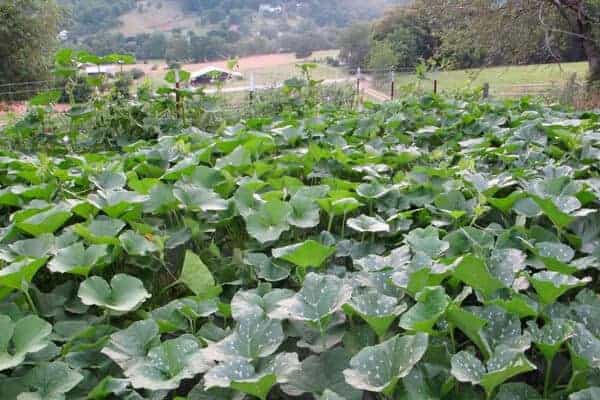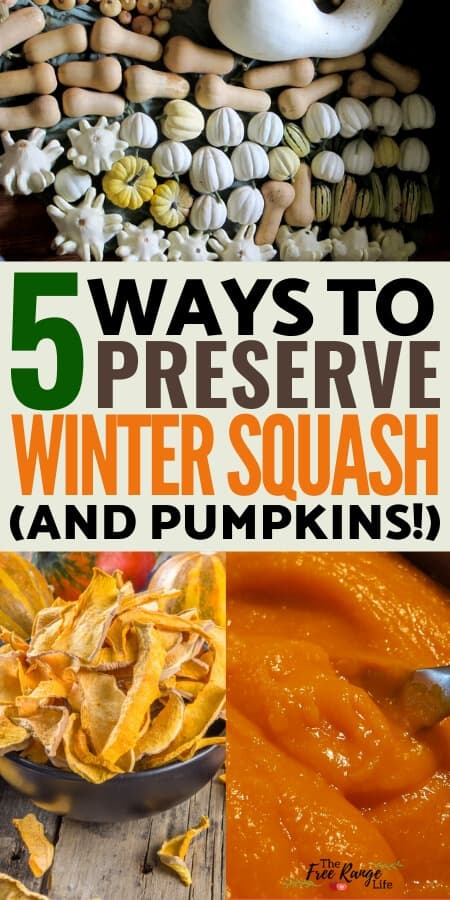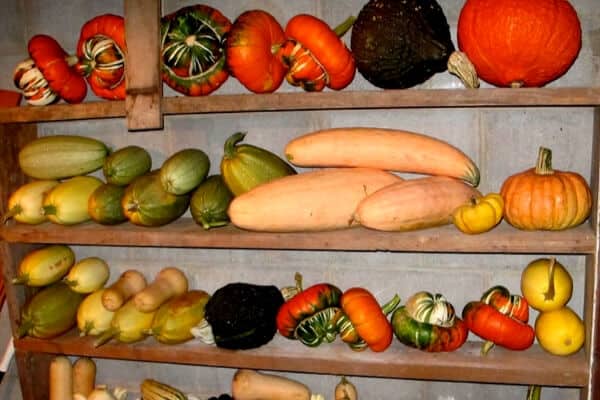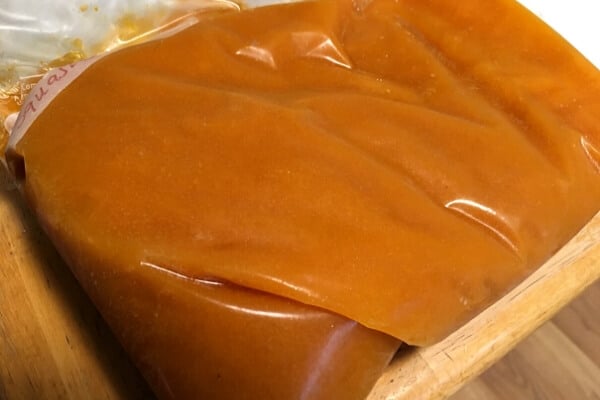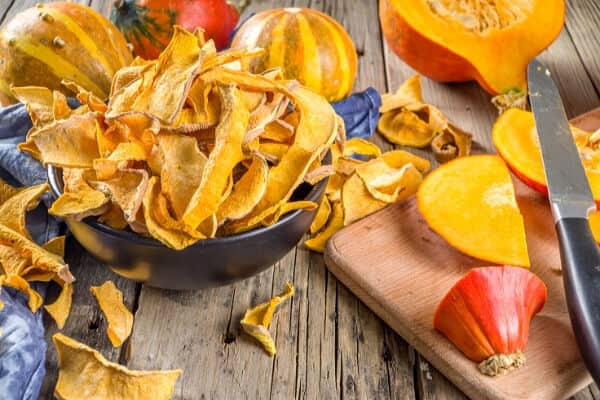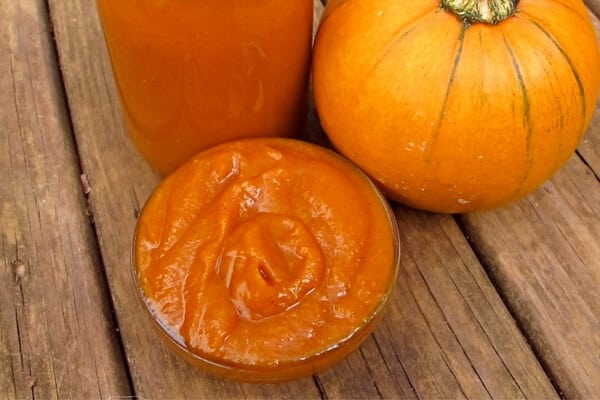Winter squash is a great garden crop that can give you a big harvest and a lot of calories. Learn all the ways you can preserve winter squash to enjoy all year long.
Winter squash is one of my favorite crops to grow. I love to experiment with the different varieties and we grow a lot each and every year.
This site contains affiliate links. If you make a purchase using one of these links, I may earn a commission. Please see my disclosure page for more information about cookies collected and our privacy policy.
The great thing about winter squash is that it’s very versatile. It can be savory or sweet and can be used in a variety of dishes from breakfast muffins to sauteed dinner to pie for dessert.
Luckily winter squash is super easy to preserve and there are a few different ways you can do it- meaning there’s a way that will work for almost every ability level and taste.
Here’s how to preserve winter squash (and pumpkins, since they area winter squash after all!)– including 5 different ways to choose from!
(Are you a beginning gardener? Here’s how to grow squash!)
What is Winter Squash?
First off, let’s talk about squash and the differences between summer squash and winter squash.
Summer squash is planted in the spring and can be planted throughout the summer for a continuous harvest. The plants are more compact and take up less room than winter squash. Winter squash tends to vine more, and it takes a longer growing season for it to grow to harvest size. It’s usually harvested in the late summer or early fall.
Winter squash varieties include butternut, Hubbard, pumpkin, and acorn. You can read more about my favorite winter squash varieties to find others to try out. Winter squash has a much longer shelf life than summer squashes, which makes it a great calorie crop to grow in your garden.
When talking about preserving squash in this article, I am talking about preserving WINTER squash, not summer squashes such as zucchini. It it’s summer squash you are looking for, check out How to Preserve Summer Squash.
5 Different Ways to Preserve Winter Squash
✅ Ready to take control of your food source and preserve more? Check out my Food Preservation Planner to help you plan and preserve more food this year!
Cure and Store
The best think about winter squash is it’s long shelf life. With proper curing and storage you don’t even have to preserve it- it will naturally just keep for months!
I currently have about butternuts on my shelf that were harvested over 8 months ago. If that’s not easy preserving, I don’t know what is!
The most important thing when it comes to storing winter squashes for long term storage is to cure them before storing.
You need to have fully ripe, unblemished squash. If they are damaged, they likely won’t store long term and should be preserved in one of the other ways I will talk about.
To cure, you want to leave the squash out in the sun for about a week. This toughens up their skin. I tend to just leave mine in the garden until it’s close to frost, picking only if I want to use one immediately.
But you can also lay them in the sun on a table or deck.
Once they are cured, wipe them down with a vinegar and water solution to kill any mold or bacteria that might be on the squash. Then store.
It’s best to store winter squash an area that stays in the 50-60F temperature range with low humidity. Don’t let them freeze! And the warmer your storage area is, the shorter your squash might last. So keep it in a somewhat cool area for the best results.
This is the best way to preserve winter squash- and it’s the easiest!
Freezing Winter Squash
You can also freeze your winter squash harvest. If I have any squashed or pumpkin with blemished skin or those that didn’t cure properly, I freeze those.
You can freeze it in a couple of ways, though pureed or diced is the most common.
Since we bake with a lot of squash (pumpkin), I like to keep a few bags of pureed winter squash in the freezer.
Just bake it at 400F until soft, then scoop out the seeds and discard and scoop out the flesh and puree in a blender or with a food processor. Allow it to cool slightly and place it in a freezer bag. Don’t forget to measure and label with the amount in each bag. You can also freeze it in a silicone muffin tray and then you have portioned sizes.
You can also freeze winter squash raw.
Start by cutting off the ends and peeling it. Cut your squash in half and scoop out the seeds. Slice and dice into the desired size, seal up in a freezer bag and that’s it.
*Cutting raw winter squash can be tough. I highly recommend ceramic knives for this job!
Pressure Canning Squash
If you want to can winter squash, you will need to use a pressure canner. It can’t be canned on their own using a water bath canner.
Pressure canning can seem a little scary if you aren’t used to it, but it’s really not that hard! You can pick up a copy of the Quick Start Guide to Pressure Canning if you need help getting started.
Pureed or mashed winter squash or pumpkins can’t be canned at home, but you can do it with cubed or diced squash.
Here are a couple tutorials on how to safely can winter squash or pumpkin:
Dehydrating Squash
Dehydrating is another great option for preserving your winter squash. I have an Excalibur 9 Tray Food Dehydrator that I LOVE and use all summer long, but you can also check out my Dehydrator Buying Guide for other options.
You have quite a few options when it comes to dehydrating squash:
- Cook and puree, then dehydrate the pureed pumpkin or squash. This is great for later use in pies and baked goods
- Peel and shred/grate raw squash, then dehydrate. This is great for grinding into squash flour/powder
- Peel and dice raw winter squash, then dehydrate. This is great for throwing in soups and stews.
Either way, place a single layer in your dehydrator and set it for 125-135F. Drying time will greatly depend on the size and thickness of the squash you are trying to dry. Puree or pieces may take 10-12 hours, and chunks may take up to 24 hours.
Here are a couple recipes to try:
- Pumpkin Fruit Leather
- Dehydrating for Squash Flour
- Squash chips (just use your dehydrator instead of the oven)
Freeze Drying Squash
Now, not everyone has a freeze dryer, but it’s still a another option for preserving winter squash and pumpkins!
Freeze drying allows you to preserve squash that retains most of its nutritional value and lasts much longer than any other preservation method- up to 25 years in some cases.
You can make freeze dried squash in slices, grated, or chunks and use it just as you would other preserved squash- in baked goods, soups, stews, smoothies, and more. You can slice them and make them into freeze dried chips- that are super crunchy and a good alternative to potato chips-without the oil!
HarvestRight makes a line of Home Freeze Dryers that work quite well for preserving all kinds of foods. Here’s their guide on Freeze Drying Squash to check out more about it.
And while, not a long term preservation option, we also love to make spiced pumpkin butter with out winter squashes. Because it’s not safe to can pureed squash at home, it can’t be canned, but it does freeze well!
Here’s my recipe for Spice Pumpkin Butter if you want to give it a try!
Or try out one of these 15 Stuffed Acorn Squash Recipes!
More Preservation Guides:
6 Ways to Preserve Strawberries
6 Ways to Preserve Green Beans

